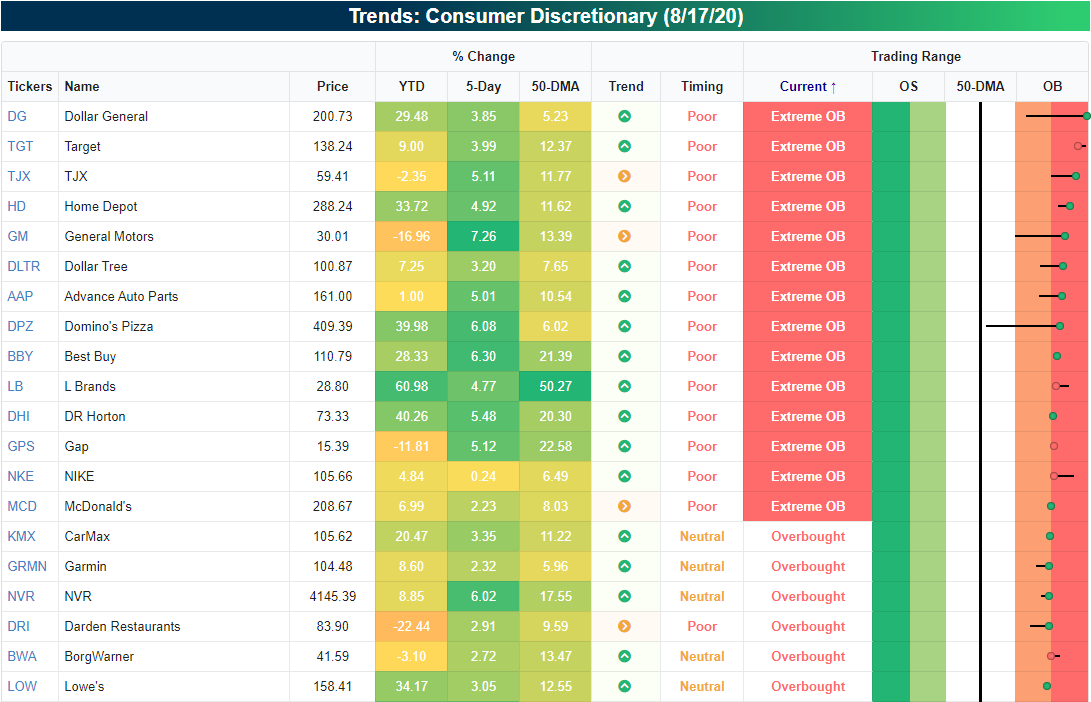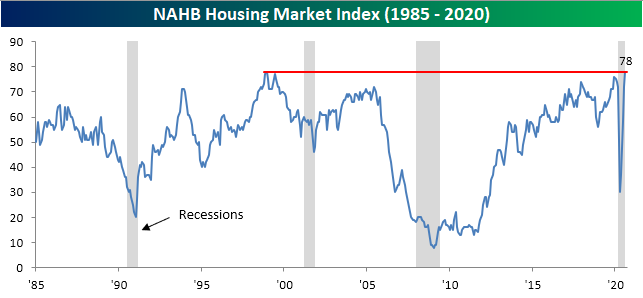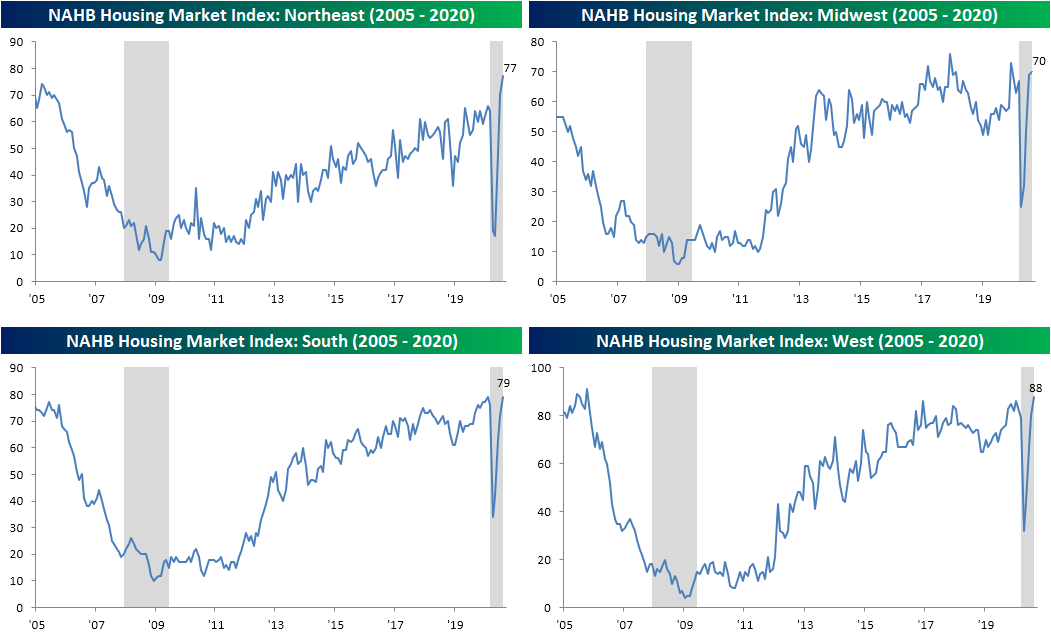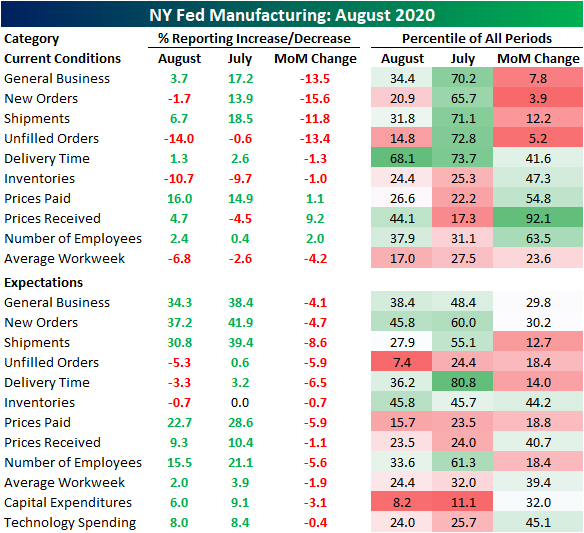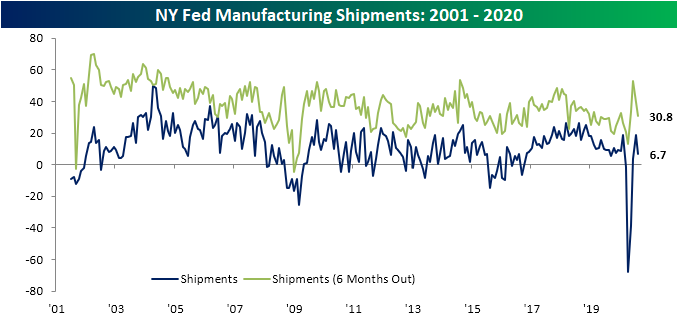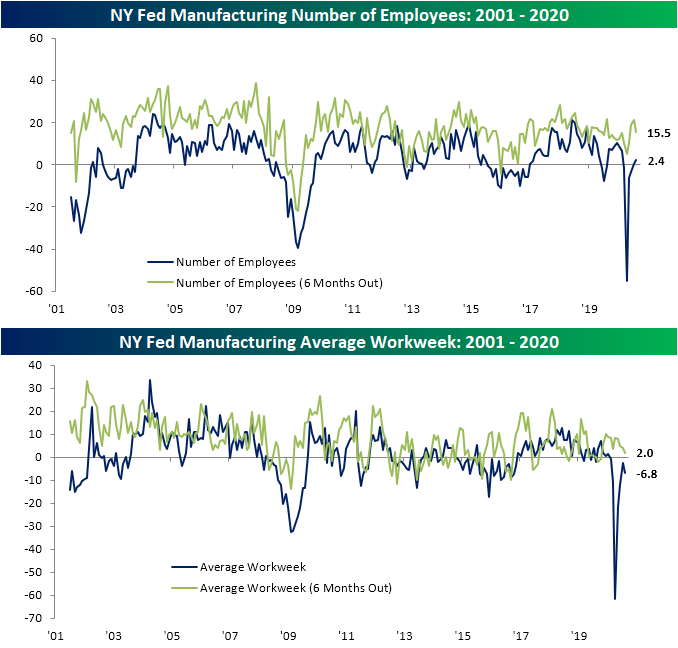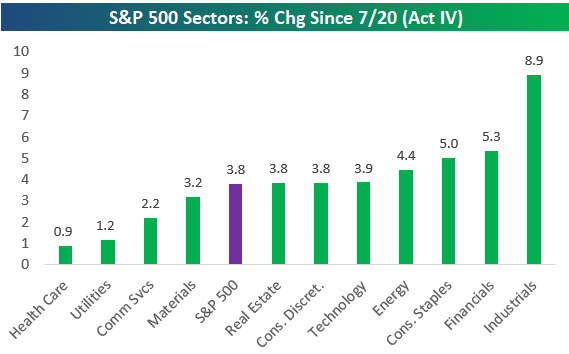Retail Earnings On Deck
Earnings season came to its unofficial end today with the release of Q2 results for Walmart (WMT). As shown in the snapshot of our Earnings Explorer below, the earnings slate has slowed considerably but there are still several reports per day over the next month. The busiest day will be August 27th with 37 reports.
Similar to today, retail earnings dominate the upcoming calendar. While WMT and Home Depot (HD) blew the doors off their reports, upcoming earnings will give a better picture of how the consumer has been impacted by the pandemic. Over the next month there are 52 retailers scheduled to report second-quarter results. Of these retailers, less than half are expected to show positive EPS. Companies that have historically beaten EPS the most include Ollie’s Bargain Outlet (OLLI), Ulta Beauty (ULTA), and Restoration Hardware (RH). In terms of topline results, Vipshop (VIPS), OLLI, and Alibaba (BABA) have topped sales forecasts the most consistently.
In terms of stock price reactions, Land’s End (LE) has averaged the strongest performance on earnings days with an average full-day gain of just under 6% with positive returns a little better than half the time. Sportsman’s Warehouse (SPWH) is the only other stock on this list to have averaged a gain of more than 5% on earnings days. SPWH along with ULTA, and Burlington Stores (BURL) have also been the ones to most consistently experience a positive stock price reaction.
Given retailers tend to be fairly seasonal businesses, the table below looks only at these companies’ beat rates and average stock price reactions in just their reports for the Q2 earnings season. As shown, Sportsmans Warehouse (SPWH) has most consistently topped EPS and sales estimates. SPWH has averaged a 9.11% gain following its Q2 reports. On a side note, PDD has a 100% beat rate for its Q2 earnings season reports, but it has only had one prior report during the Q2 earnings season. While SPWH has seen positive returns, stocks like At Home Group (HOME), Duluth Trading (DLTH), and Vipshop (VIPS) have all averaged the worst performance fin reaction to their Q2 earnings reports.
As for where retail stands ahead of their earnings, the snapshot below from our Trend Analyzer shows the 20 most overbought stocks in the sector. Many of the stocks making the cut are retailers that are currently extremely overbought after sizeable runs. As of Monday’s close, the average S&P 500 retail stock is 1.7 standard deviations above its 50-DMA. Click here to view Bespoke’s premium membership options for our best research available.
One Streak Ends, A Longer One Continues
It was a big, albeit brief, moment for the market today when the S&P 500 notched a new intraday record high, fully erasing all of the declines from the COVID-crash in February and early March.
Today’s new high for the S&P 500 ended a streak of 125 trading days without a record intraday high. The chart below shows prior streaks of trading days without an intraday high since 1983 (when our intraday database begins). What’s amazing about the current period is that despite losing roughly a third of its value, the 125 trading day gap between record highs is barely even a blip on the chart, and doesn’t even rank in the top ten in terms of longest streaks without a new high. Even looking at more recent history, since the S&P 500 took out its pre-financial crisis high in early 2013, there have been three other streaks where the S&P 500 went longer without notching a new all-time high.
The S&P 500 may have notched a record high this morning, but it’s a much different picture for the small-cap Russell 2000. At the same time that confetti was streaming for the S&P 500, the Russell not only remains well below its February high, but it’s also nearly 10% below its record high from nearly two years ago at the end of August 2018.
While the S&P 500’s just-ended streak of 125 trading days without a record high wasn’t even one of the ten longest, the current streak of 493 trading days that the Russell 2000 has gone without a new high ranks as the 5th longest streak since 1983. Comparing the chart of Russell streaks below to the same chart for the S&P 500 shows that the Russell has been much more streaky. While the S&P 500 has only had three prior streaks of longer than 400 trading days without a new high, the current streak for the Russell ranks as its eighth such streak of more than 400 trading days. Start a two-week free trial to Bespoke Institutional for full access to our research and interactive tools.
Bespoke’s Morning Lineup – 8/18/20 – Off the Charts Sales
See what’s driving market performance around the world in today’s Morning Lineup. Bespoke’s Morning Lineup is the best way to start your trading day. Read it now by starting a two-week free trial to Bespoke Premium. CLICK HERE to learn more and start your free trial.
“As sure as the spring will follow the winter, prosperity and economic growth will follow recession.” – Bo Bennett
Up until a few minutes ago, the most impressive stats of the morning were the monster comp sales growth numbers from Home Depot (HD) and Walmart (WMT), but the just-released Housing Starts and Building Permits reports for the month of July blew the doors off expectations. Housing Starts were expected to come in at a level of 1.24 million on a SAAR basis but came in more than 200K higher at 1.496 million (highest since February). Building Permits were similarly strong. While economists were expecting the headline reading to come in at a SAAR level of 1.32 million, the actual reading was just under 1.5 million. That was the best reading for Building Permits since January.
If you’re keeping track at home, Retail Sales hit a record high on Friday, and now Housing Starts and Building Permits are back to pre-pandemic levels. Obviously, these strong numbers have been aided by the relief programs put in place in response to the COVID outbreak, but the strength does show that these programs were effective.
Be sure to check out today’s Morning Lineup for a rundown of the latest stock-specific news of note, market performance in the US and Europe, trends related to the COVID-19 outbreak, and much more.
As mentioned above, the most impressive numbers of the morning originally were the same-store sales results from Home Depot and Walmart. Same-store sales at WMT increased by 9.9% while HD sales increased by over 23%. Keep in mind that these numbers cover a period where the US economy is in a recession!

Daily Sector Snapshot — 8/17/20
Homebuilders Head Higher and Higher
This morning’s release on homebuilder sentiment provided more reinforcement as to just how strong the housing market has been despite – or even thanks – to the pandemic. The NAHB’s Housing Market index rose another 6 points in August to 78, surpassing the pre-pandemic high of 76 from December, and now ties December of 1998’s reading for the highest in the history of the index.
Not only is the index at its joint highest level ever, but the 6 point increase this month was no small move to get there, registering in the top 95% of all monthly changes. Excluding the past few months’ readings, August’s jump was the largest monthly gain since March of 2017. Breadth was also strong with every sub-index and all regions rising month over month; many of those are now at or close to fresh records.
While the headline index is right at its record high, the index for Traffic reached a new record this month surging 9 points to 65, surpassing its prior high of 62 from December of 1993.
Broken down by the four regions of the country, each one is strong, but the Northeast has seen some the biggest moves in the past few months and is now at a record high. People are fleeing city apartments and looking for homes. Similar to the headline index, the South is also tied for a record. That index rose 7 points to 79 in August to return to its February levels.
With several aspects of the pandemic boosting housing, the homebuilder stocks have continued to surge. Just like homebuilder sentiment, the S&P 500 Homebuilders group is also at an all-time high today. It actually first made a new high last week after taking out the prior high from July of 2005. Start a two-week free trial to Bespoke Institutional to access our interactive economic indicators monitor and much more.
Bad Breadth From the Empire Fed
The first of the regional Fed manufacturing indices for the month of August was released this morning in the form of the Empire State Manufacturing Survey. The headline number reversed lower sequentially for the first time after three straight months of large gains off of the April record low. The index fell 13.5 points—the nineteenth largest of any month on record—to 3.7. That indicates the region’s manufacturing sector still expanded for a second straight month in August, but that was at a slower pace than July. Meanwhile, outlook for six months in the future has continued to decline from the June multi-year high. The future expectations index deteriorated for a second consecutive month with that index declining MoM by 4.1 points to 34.3. Outside the previous two months, that is still the highest level of the index since June of 2018.
Although overall activity still rose in August, the deceleration was notable with the MoM decline in the bottom decile of all monthly changes while breadth was weak. Of the 10 individual components, only three rose in August. Those were the indices for prices paid and received and the number of employees. Breadth was even weaker for the indices for future expectations as not a single one rose in August. In other words, although business concretely improved in August, it was at a slower pace than July while businesses are also less optimistic than they were one month ago.
The index which experienced the largest pullback was for New Orders which fell by 15.6 points from an expansionary reading of 13.9 to a contractionary reading of -1.7. Outside of the massive drops in March and April as well as a 17.9 point decline last June, you would have to go back to 2010 to find another larger drop in New Orders. The index for Shipments likewise experienced a significant decline falling from 18.5 to 6.7, but that was only in the 12th percentile of all months (compared to the 3rd percentile for New Orders) and that still leaves that index in expansionary territory. Overall, these readings showed slowed demand in August.
Unlike just about every other category of the report, the indices for unfilled orders and inventories have still yet to show an expansionary reading in the COVID era. This month, both are indicating businesses are continuing to fulfill existing orders and work off the inventory spike from February. For unfilled orders, this month’s 13.4 point decline was in the bottom 5% of monthly moves but did not bring it to any new recent low. Meanwhile, the index for inventories fell to 10.7 which is just short of a multi-year low, slightly above the July 2019 level of 10.9.
In addition to prices (both received and paid), the only other current conditions index in this month’s report to rise was that for the number of employees. That index rose 2 points to 2.4. That is the first back to back expansionary readings since January and February of this year. Although businesses are increasing hiring, work hours continue to fall. The index for average workweek remains in contraction as it has for the prior six months and expectations have also continued to deteriorate. Click here to view Bespoke’s premium membership options for our best research available.
Chart of the Day: Passenger Traffic Taking Off
Bespoke’s Morning Lineup – 8/17/20 – An Unconventional Rally
See what’s driving market performance around the world in today’s Morning Lineup. Bespoke’s Morning Lineup is the best way to start your trading day. Read it now by starting a two-week free trial to Bespoke Premium. CLICK HERE to learn more and start your free trial.
“The most dangerous people in the world are very smart traders who have never gotten their teeth kicked in.” – F. Helmut Weymar
There’s not a whole lot going on in terms of newsflow to kick off this mid-August Summer week, but futures are higher as convention season kicks off, first with the Democrats and then the Republican party to follow next week. Normally, the selection of a VP candidate and the subsequent convention provides a boost in polling for challenger candidates, but so far Biden hasn’t seen any bounce in his election odds since the VP announcement last week. Granted, he is already ahead in polling, so that could be playing a role, but we’ll see how betting market trends play out over the course of this week.
In economic data, homebuilder sentiment must have been so good that they released it early. The report was supposed to be released at 10 AM eastern but instead came out at 8:07. While economists were expecting the headline reading to come in at 74, the actual reading was tied for a record high at 78. Obviously, homebuilders are feeling good!
Empire Manufacturing for August was just released and, while positive at 3.7, it missed the consensus expectation of 15.0.
Be sure to check out today’s Morning Lineup for a rundown of the latest stock-specific news of note, market performance in the US and Europe, trends related to the COVID-19 outbreak, and much more.
If there has been a reliable trend in the market over the last several years, it has been the leadership of the Technology sector. While there have been days or weeks where tech lags and value rallies, more often than not, it all comes back to tech, especially when the market is rallying. So far this quarter, though, tech hasn’t been leading, and it hasn’t even been playing second fiddle. In fact, Technology finds itself in the unconventional position where it is actually underperforming the S&P 500 quarter to date (QTD)! While sectors like Consumer Discretionary (1276%), Industrials (12.63%), and Materials (11.02%) are all up by double-digit percentages, the Technology sector’s ranking in terms of QTD performance is actually 6th out of 11 at 8.77%. What a dog.

Bespoke Brunch Reads: 8/16/20
Welcome to Bespoke Brunch Reads — a linkfest of the favorite things we read over the past week. The links are mostly market related, but there are some other interesting subjects covered as well. We hope you enjoy the food for thought as a supplement to the research we provide you during the week.
While you’re here, join Bespoke Premium with a 30-day free trial!
China
The Fortune Global 500 is now more Chinese than American by Alan Murray and David Meyer (Fortune)
Th newly updated Fortune 500 list of the 500 largest companies by revenue has more companies from China and Hong Kong than the US, a first. Back in 1990, when the list was first published, there were no Chinese firms tallied. [Link]
China’s Days as World’s Factory Are Over, IPhone Maker Says by Debby Wu (Bloomberg)
Apple supplier Hon Hai Precision Industry (aka Foxconn) is planning on splitting its supply lines between China and the rest of the world; it’s already shifted about 5% of production capacity outside of mainland China over the past year. [Link]
Business Shifts
The Visa Back to Business Study (Visa)
A long report discussing a survey and internal data from Visa focused on small businesses. Contactless payments, a focus on revenues, and digital commerce driving growth are all key takeaways. [Link; 25 page PDF]
Amazon and Mall Operator Look at Turning Sears, J.C. Penney Stores Into Fulfillment Centers by Esther Fung and Sebastian Herrera (WSJ)
Simon Property Group, the largest mall operator in the US, has been in talks with Amazon to turn anchor spaces that used to be filled with department stores into small distribution hubs that could serve as warehouses for “the everything store”. [Link; paywall]
City Stories
After Chicago Looting and Coronavirus, Businesses Consider Closing Shop by Joe Barrett (WSJ)
Chicago businesses are struggling to manage both the slowdown in traffic driven by COVID and the impact of looting in recent weeks. [Link; paywall]
Retail Chains Abandon Manhattan: ‘It’s Unsustainable’ by Matthew Haag and Patrick McGeehan (NYT)
With foot traffic all but gone, what was once some of the most valuable retail real estate in the country has collapsed into a quagmire of unprofitable stores and empty restaurants. [Link; soft paywall]
City Fiscal Conditions 2020 (National League of Cities)
A brutal report on the outlook for city finances, wrecked by an unprecedented shift in economic activity that has destroyed revenue models based on property and sales taxes alike. [Link; 28 page PDF]
Vaporware
This Investment Burned Almost Everyone by Spencer Jakab (WSJ)
An exchange-traded note that theoretically moves inverse to natural gas sky-rocketed after its issuer (Credit Suisse) halted issuing new shares; the notes traded from $400 to nearly $25,000 before a subsequent retirement of the shares at face value. [Link; paywall]
Software firm MicroStrategy makes a massive bet on Bitcoin with a $250 million purchase by Jeff John Roberts (Fortune)
A small software firm in Virginia has converted its corporate cash holdings into Bitcoin, in some unique blend of risky speculation and publicity stunt. [Link]
COVID
A Cheap, Simple Way to Control the Coronavirus by Laurence J. Kotlikoff and Michael Mina (NYT)
Tests that use a simple piece of paper and the subject’s spit will soon be available and are vastly cheaper than lab-based testing, which opens up the possibility individuals will know much sooner if they’ve been exposed to COVID. [Link; soft paywall]
Futility For Utilities
Amid power outages, CEO of generator maker anticipates ‘massive change’ coming to the grid by Tyler Clifford (CNBC)
With hurricanes and major storms increasingly threatening the aging electrical grid, small generators like those sold by Generac are getting more attractive for consumers that want permanent access to power. [Link]
Sports Lotteries
1986-87 Fleer Basketball Case Sells for Record-Breaking $1.78 Million by Darren Rovell (Action Network)
A 35 year-old case of basketball cards which contains over 400 packs of cards (and likely at least 36 Michael Jordan rookie cards valued at $80,000 or more) has sold for $1.8mm. [Link]
Read Bespoke’s most actionable market research by joining Bespoke Premium today! Get started here.
Have a great weekend!
The Bespoke Report — World Record
This week’s Bespoke Report newsletter is now available for members.
Given the rotation we’ve seen into “re-open” areas of the market since July 20th, we can now confidently say that we’re in the midst of “Act IV” of the current bull market.
Below is our chart of the S&P 500 since last December highlighting what is now a four-act bull. Act I was the strongest and led by Tech, Health Care, and Energy. Act II saw huge gains from “re-open” plays as the first wave of COVID subsided. Act III saw sideways action for the broad market but big gains from Tech/FAANG as COVID cases began to rise again. And finally, Act IV has been led once again by re-open stocks in Industrials, Transports, and Financials, while the Tech sector and “COVID Economy” stocks have taken a breather.
We cover markets and the economy in much more detail in our weekly Bespoke Report newsletter. To read the report and access everything else Bespoke’s research platform has to offer, start a two-week free trial to one of our three membership levels. You won’t be disappointed!



